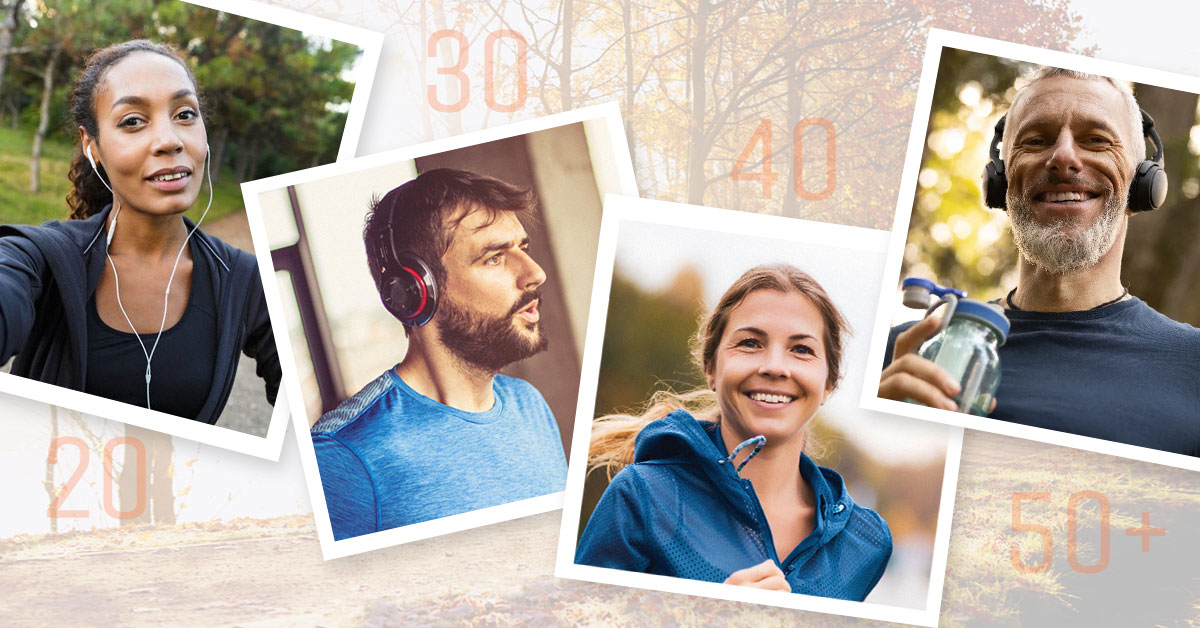Service by appointment only
Call 020 7736 0046
Call 020 7736 0046 To book

Running is a fantastic way to stay fit, clear your mind, and challenge yourself. However, as we age, our bodies change, and so do the challenges of running. One study found that with every decade, stride length as well as speed of runners decreases by 20%.
Understanding how running performance evolves over time can help runners of all ages adjust their training and recovery methods to stay healthy and competitive. Whether you’re in your 20s or your 60s, you can begin to enjoy running and it can remain a vital part of your life if it is approached thoughtfully.
Running in your 20s:
Building a strong foundation
For most runners, their 20s represent a time of peak physical condition. During this decade, muscle mass, cardiovascular capacity, and bone density are at their highest. A strong VO2 max, or the maximum amount of oxygen your body can consume during exercise, is an additional advantage in this decade, allowing for excellent endurance.

Younger athletes sometimes fail to take sufficient care of their bodies. Sub optimal nutrition, inadequate hydration, and irregular sleep can hamper performance and increase injury risk. The key to thriving as a runner in your 20s is balance – self-regulation is crucial.
However, it’s not all smooth sailing. Runners in their 20s may begin to experience early signs of wear and tear.
Running in your 30s:
Focus on consistency and recovery
The 30s are an excellent time for distance runners. The fast-twitch muscle fibres, which are key for speed, begin to decline before slow-twitch fibres, making it easier to excel in distance events than sprints.

This decade often comes with increased life responsibilities, which can affect training consistency. Weight gain may also creep in due to a naturally slowing metabolism so it’s important to incorporate strength training and maintain regular running or cross-training routines. The metabolism can be kept in check with higher-intensity runs like tempo work or increased mileage.
Remember, running footwear should be replaced ideally between 350 and 550 miles. As training requirements change, a change in footwear may be needed – especially when you notice more wear and tear in your footwear, or you notice instabilities in running movement.
At Profeet, we can carry out a gait analysis as well as a footbed check, identifying pressure points in your stride. We will ensure you have correct supportive footwear with custom orthotics if needed to improve comfort and functionality when you run.
Running in your 40s:
Prioritise strength and flexibility
By the time you reach your 40s, you might notice that recovery takes longer. However, muscle mass and endurance can be maintained with consistent effort, and your experience as a runner is now your most powerful asset. Focusing on strength training and speed work can help to offset declines in VO2 max, allowing you to remain competitive, especially with long distances.

Women in their 40s may experience the early effects of menopause, including reduced muscle mass and bone density, due to a drop in oestrogen levels. Strength training and weight-bearing exercises are crucial to maintaining bone health and muscle mass.
Allison Swan, Women’s Health physio at Physio Remedies, says:
Women now can now have the confidence that training in their 40s and 50s is not just about feeling and looking good but an essential aspect in maintaining and improving a strong and healthy body both mentally and physically.
Strength and conditioning is now backed up by scientific research. It is important for women to maintain/ improve muscle function, for strength and joint mobility.”
Running in your 50s and beyond:
Consistency and longevity
As you enter your 50s and beyond, running becomes more about consistency and injury prevention than speed. While muscle strength can be relatively well-maintained, speed, especially in shorter distances, naturally declines. Staying consistent with your mileage and training routine is key to maintaining endurance and fitness.

Cross-training, running on softer surfaces, and incorporating strength exercises will support bone health and maintain muscle mass. Balance exercises like yoga can help maintain coordination and stability, while flexibility work ensures your muscles and joints remain supple.
How Profeet keeps you running stronger for longer
No matter your age, Profeet’s custom insoles can make a big difference in your running performance and longevity. As your body changes, proper support becomes even more critical to prevent injury and maintain good running form. Whether you’re dealing with hormonal shifts, recovering from injury, or simply looking to improve your performance, custom insoles can provide the tailored support your feet need. By improving alignment and cushioning, Profeet insoles can reduce the strain on your joints and muscles, helping you run longer, recover faster, and stay injury-free.
Incorporating strength training, flexibility exercises, and using supportive gear like custom insoles are key strategies to keep running strong across all ages. Stay active, stay smart, and keep enjoying the many benefits that running brings to your life!
Call 020 7736 0046 to book your appointment or book online
OUR SERVICE IS BY APPOINTMENT ONLY
Profeet’s services are by appointment only, please call or book online in advance
